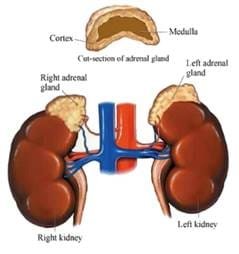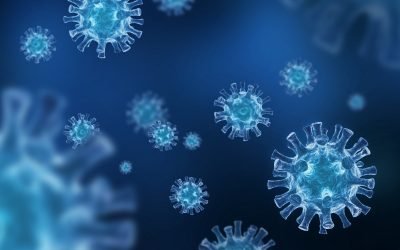In 1881, neurologist George Miller Beard, M.D., published a book called American Nervousness, Its Causes and Consequences in which he describes how the depletion of nerve energy (the energy that powers the nervous system) results in the state of nervous exhaustion and general debility referred to at that time as neurasthenia. The characteristic symptoms of neurasthenia included fatigue, depression, nervousness and anxiety, weak digestion and headaches.

Beard viewed neurasthenia as the product of the stresses and strains of pressure-filled, hectic, fast-paced, American urban existence and so he referred to it alternatively as “American nervousness.” He contended that the only way to resolve this condition was to withdraw from the pressures of urban life, get lots of rest, and adopt a simpler, healthier lifestyle.
It was soon recognized that neurasthenia was not a uniquely American condition but one that was common to citizens of modern societies all around the world. To some extent, the diagnosis of neurasthenia assuaged the sufferers fear that their condition was an indication of mental illness but rather one rooted in the overload and subsequent depletion of physiological, adaptogenic mechanisms (i.e., mechanisms that help the organism adapt to stress by exerting a compensatory adjusting action upon the organism’s stress-response processes).
In Western medicine, the diagnostic term “neurasthenia” is now considered to be an archaic one (although it is still used in psychiatry in China and Japan). What was once defined as neurasthenia is now called, depending upon the qualities of the symptomatic presentation, clinical depression or fibromyalgia or post-traumatic stress disorder or chronic fatigue syndrome.
In anthroposophical medicine–an integrative, multimodal treatment system, developed in the 1920s, based upon Rudolf Steiner’s and Dr. Ita Wegman’s holistic understanding of man and nature and of disease and treatment–and the art of Spiritual PhytoEssencing (into which I have adapted some of the central concepts of anthroposophical medicine), the concept of neurasthenia is more concisely elaborated.
Anthroposophical medicine describes two constitutional archetypes: Hysteria and Neurasthenia. The development of these two constitutions derives from the weakening of both the organism’s warmth organization (the functions involved in the production and distribution of warmth throughout the body) and mind-body rhythmicity (associated with rhythmic physiological processes such as heartbeat and breathing as well as the psychospiritual faculty of feeling), often due to traumatic experiences in early childhood which disturbed the inner core of the self-structure where it first emerges from the soul.
At the level of the brain, nervous system and senses (i.e., the nerve-sense system), soul forces unite directly with the organism and follow the nerve tracts, inducing structural organization and catabolism. Catabolism refers to metabolic processes in which complex substances are broken down by living cells into simple compounds, resulting in the liberation energy for use in work, energy storage, or heat production. In general, catabolism can also be defined as the sum of all degradative processes in the body, including the breakdown of worn or diseased tissues.
In the neurasthenia constitution, the nerve-sense system (nervous system and senses) predominates, thus, its projection of catabolic currents becomes too intense and persistent. As a result, the nerve-sense system “burns out” and no longer has sufficient vigor to guide the anabolic processes of growth and regeneration. Anabolism, the opposite of catabolism, is the constructive phase of metabolism, in which the body cells synthesize cellular materials for growth and repair.
Accordingly, the neurasthenic individual becomes overactive mentally while physically inertial and debilitated. The catabolic processes dominate because of a decline in the anabolic ones. This predominance of the nerve-sense system leads to hypercreation of mentalness with oversensitivity to sensory stimuli and resultant irritability and introversion. There is also significant sleep disturbance with symptoms such as difficulty falling asleep, insufficient depth of sleep and awakening too early.
The keynotes of neurasthenia are: nerve-sense system predominates; chilliness; catabolic trend; oversensitivity to sensory stimuli; mentally overactive, but physically inertial and debilitated; irritability and introversion; sleep disturbances.

Clearly, neurasthenia (“American nervousness”) is not associated exclusively with late 19th century American life. If anything, it is far more common in 21st century existence. A concise way of describing the 21st century neurasthenic state is being “wired and tired.”
As opposed to those who lived in the 19th century, modern 21st century individuals commonly fuel their days with caffeine and devitalized processed, highly sugared foods and are immersed in a sea of harmful radiation. Computers along with all other digital devices such as cell phones, emit harmful electromagnetic rays and frequencies. People have become addicted to cell phone communications, spending hours each day chatting, texting and wandering through social media. All of this sustains the trend toward the over-amplification of the currents of the nerve-sense system, and thus, the development of neurasthenia in susceptible individuals.
Accordingly, the cell salt Kali. phos. (i.e., Kalium Phosphoricum – Latin for Potassium phosphate) has become increasingly relevant since it was introduced by Dr. W.H. Schuessler in the late 19th century. So much so, that a large portion of the 21st century population would benefit from the use of this invaluable cell salt.
Cell Salts
In the 19th century, Schuessler (1821-1898) a German medical doctor and homeopath, made a discovery, the importance of which has never been appreciated nor acknowledged by conventional medicine. Schuessler, by way of analyzing the ash of cremated human remains, discovered the prominent presence of twelve proportionately occurring mineral salts.
In chemistry, a mineral salt is an ionic compound (consisting of ions: electrically charged atoms or molecules) that is produced by a reaction between an acid and a base: an alkaline substance. Salts are composed of positively charged ions (i.e., cations) bonded with negative ions (i.e., anions), the product of which is an electrically neutral (without a net charge) compound. The salt we use to season our food (sodium chloride) is only one type of mineral salt, not the only one.
When living tissues are reduced to ash, all the organic (i.e., living) matter is consumed; all that remains are minerals (inorganic– not consisting of living matter) since they are combustible only at very high temperatures of between 4,000 and 10,000 degrees centigrade (approx. 7200 to 18,000 degrees Fahrenheit). Chemical and spectral analyses can then be used to determine the identity of these minerals.
Schuessler eventually performed similar qualitative and quantitative analyses of various tissues (e.g., bone and muscle) and bodily fluids such as blood, lymph and breast milk. From this, he discovered that certain of these same twelve mineral salts were more prominent than others within specific tissues and fluids. For example, while potassium phosphate and magnesium phosphate are strongly present in muscle and nerve tissue, potassium chloride is more prominent in mucous membranes and calcium phosphate in bone.
Based upon these discoveries, Schuessler theorized that these mineral salts were the essential building blocks of life. He felt that the function of the trillions (the latest estimate are that there are approximately 30 to 70 trillion cells in the human body) of body cells hinged upon the presence of these mineral salts in proper proportions. Therefore, said salts became known as the “cell salts.”
Schuessler’s twelve cell salts are: calcium fluoride, calcium phosphate, calcium sulfate, iron phosphate, magnesium phosphate, potassium chloride, potassium phosphate, potassium sulfate, sodium chloride, sodium phosphate, sodium sulfate and silica.
Schuessler went so far as to say that the cell salts are the vital portions of the body; the other substances in the body such as water, proteins and fats are merely inert matter used by these cell salt masters in maintaining cellular integrity. Of course, we now know that to be an erroneous notion not supported by more modern scientific research. Nevertheless, there is no doubt that these cell salts are vital to cell function, and a deficiency or imbalance in their collective presence will result in dysfunction and disease. On the other hand, supplementation with the proper cell salts which will correct such deficiency and imbalance can help to restore body cells to a healthy state.
Schuessler believed that the salts had to engage directly with diseased or devitalized cells. Thus, being a homeopath as well as a medical doctor, he prepared his cell salts using the homeopathic method of sequential dilution and potentization. The resultant high dilution enables the few remaining molecules of each mineral salt to bypass obstructions in the body and to then be utilized by the cells independent of the processes of digestion and assimilation that are often weakened and inefficient in an ill or devitalized individual.
In this reference, the great 19th century German biochemist Justus von Liebig stated: “It happens that a tissue in disease reaches a degree of density, becomes so clogged, that the mineral salts of the blood cannot enter the cellular milieu to feed and nourish: but, if for therapeutic purposes a solution of a cell salt be given so diluted, that all of its molecules are set free, it is presumable that no hindrance will be in the way of these molecules to enter the abnormally condensed part of tissue.”
For a complete discussion of cell salt theory and practice, read my article:
Kali. Phos. (Potassium Phosphate)
Most prominent locations: brain; nerves; muscles; blood cells
Deficiency Keynotes: nerve and nervous symptoms; brain symptoms; insomnia; metabolism and cellular respiration; adrenal fatigue and deficiency; anxiety; depression; chronic fatigue; weakened digestion; autotoxemia; chronic infections.
Modalities (i.e., symptoms which are better or worse for): aggravated by noise, exertion and rising from a sitting position; pains worse for continuous exertion or after rest; worse for cold; symptoms better for rest, warmth, gentle motion, eating and being with pleasant company; worse when alone.
Spiritual PhytoEssencing Essential Oil Association: Pine(Pinus spp.)
Kali. phos., a nerve nutrient, is the cell salt for conditions in which the nerves and nervousness are a central etiological factor. School children often benefit from this cell salt as it sharpens cognitive functions and helps maintain an emotional contentment.
Kali. phos. is a specific for nervous headaches, nervous dyspepsia (i.e., indigestion), sleeplessness, depression, languid weariness, lowered vitality and irritability. As an important constituent of nerve tissue, it exerts a diverse and powerful influence on the bodily functions and is the primary cell salt for any disorder caused, or exacerbated by, a stressed-out nervous system.
Kali. phos. is also indicated for chronic skin disorders, such as eczema and shingles, whose flare-ups are commonly the product of an underlying nervous state. Similarly, it is of potential value in the treatment of nervous asthma.
Symptoms that indicate the potential relevance of Kali. phos. cell salt remedy include: anxiety; nervous dread without any special cause; fretfulness; impatience; ill-humor; gloomy moods; looks on the dark side of everything; dark forebodings; brain fatigue from overwork; timidity; sighing; weeping mood; nervous headaches; nervous asthma; nervous dyspepsia; restlessness; sleeplessness after worry or excitement; yawning, stretching and weariness; hysterical yawning; depression; languid weariness; lowered vitality; irritability; delirium tremens; muscular debility; vertigo when rising from lying to standing up; feeling of faintness or dizziness in nervous people; faintness from fright or fatigue; sensitivity to noise and light; atrophic conditions in old people; nosebleeds in weak, delicate constitutions; tongue coated brownish like mustard; predisposition to bleeding gums; indigestion with nervous depression; pancreatic weakness with flatulence and distress about the heart and left side of the abdomen; menstruation late, scanty and/or painful in nervous, sensitive women; tendency toward miscarriage; bladder weakness; frequent urination or passing of much urine, sometimes scalding; neuralgia; irritating skin ailments such as shingles; eczema related to hypersensitivity and nervousness; symptoms worse from mental and physical exertion and from cold; symptoms ameliorated by rest, warmth and sometimes by eating.
Adrenal Insufficiency or Burnout


The Kali. phos. symptom picture suggests that this cell salt is a specific for adrenal fatigue.
The adrenal glands are rounded, disc-shaped glands about 3-4 inches across that are attached to the top of each kidney. The adrenal glands, essential for life, secrete a number of hormones that prepare the body to respond to stress challenges. The hormonal secretions of the adrenal glands include: adrenalin (aka epinephrine), noradrenalin (aka norepinephrine), cortisol, cortisone, aldosterone, estrogens, testosterone, progesterone, pregnenolone and DHEA. These hormones regulate many bodily activities with adrenalin and cortisol being particularly central to the activation of the body’s fight-or-flight stress response.
The adrenal glands are innervated and stimulated by activity of the sympathetic nervous system (SNS) branch of the autonomic nervous system (ANS) – the branch that up-regulates various physiological mechanisms in response to stress challenges.
The adrenal glands are designed to accommodate transient acute stress challenges (e.g., being chased by a bear, experiencing a tornado, etc.). However, the relentless elevated stress levels of the 21st century ultimately depletes these endocrine glands, thus establishing adrenal fatigue (aka adrenal insufficiency). Adrenal fatigue involves a decline in the adrenal gland’s ability to carry out its normal hormonal functions.
Some of the hallmark symptoms of adrenal fatigue are chronic fatigue, agitation and/or depression. Other symptoms include: low self-esteem and fearfulness due in part to lower cellular energy production; loss of interest in relationships; anxiety; apathy; despair; increased tendency toward suicidal thoughts; need for excessive amounts of sleep; pronounced environmental sensitivities; decreased resistance to infection; subnormal body temperature; decreased tolerance to cold; weakened blood circulation; low blood sugar (hypoglycemia); craving for sweets; food sensitivities; insufficient secretion of hydrochloric acid in the stomach; tendency to constipation; joint pain; muscle weakness.
How to Use Kali. Phos.
Cell salts are mixed via homeopathic dilution with a specific proportion of lactose and then formed into very small tablets. These tablets are administered sublingually (dissolved under the tongue). Over the years, I have encountered a few individuals who could not tolerate these lactose-based tablets. In that case, the alternative to lactose-based tablets are cell salts sold diluted in an alcohol/water solution.
Cell salts can be administered several times daily in accordance with the severity and/or persistence of symptoms. It is best to take them away from meals as food may interfere with their sublingual absorption. I have found it advantageous to take a few sips of room temperature or warm (not hot) water after each dose.
Also, don’t touch cell salts, pour them into the bottle cap and then transfer from cap to mouth. Cell salts are homeopathically diluted. Typically, cell salts are taken in dilutions of 1:1,000,000,000 or higher. If you touch them with your fingers, the minute amount of cell salt molecules will dissolve into the moisture of your skin and none will be left in the cell salt by the time you place the tablets in your mouth.
Synergistic Cell Salts that may prove of value when used in conjunction with Kali. phos. regarding Neurasthenia and Adrenal Fatigue:
Calc. phos. (Calcium phosphate) and Mag. phos. (Magnesium phosphate)
It is beyond the scope of this article to explain all the intricacies of using different cell salts in concert. This topic will be covered in detail in my books or webinars.
Herbal Extracts Synergistic with Kali. phos. Regarding Neurasthenia and Adrenal Fatigue
Note: For the last several years I have been developing a method that utilizes mixtures of herbal extract powders. Herbal extract powders generally cost significantly less than encapsulated extracts and can also be mixed together in customized combinations. I will provide more detail about this method both during my upcoming course as well as in a future Nature’s Therapies article.
Cordyceps extract powder (Cordyceps sinensis: a medicinal mushroom): stimulates the immune system; increases the efficiency and stamina of the circulatory system; general body adaptogen; dilates the bronchial airways, resulting in higher blood oxygen levels.
Boswellia serrata extract powder (Indian frankincense): modulates the immune system and inhibits inflammatory activity; reduces pain; interferes with the production of inflammation promoting cytokine; reduces hypersensitivity; helps regulate lymphocytes (white blood cells) and T-cells interactions; helps regulate production of immunoglobulin G (IgG) antibodies, which protect the body from bacterial and viral infections; helps regulate production of immunoglobulin M (IgM) antibodies, which are found mainly in the blood and lymph fluid, thus aiding in the control of a number of different autoimmune disorders.
Maca root powder (Lepidium meyenii): a type of cruciferous vegetable native to the Andes of Peru; a potent adaptogen (i.e.; helps the body naturally adapt to stressors); improves sexual health; balances estrogen levels; boosts male fertility; balances hormone levels; helps alleviate menopause symptoms; boosts energy level, mood and memory.
Ashwagandha extract powder (Withania somnifera): counteracts low thyroid function; relieves adrenal fatigue; potent adaptogen; counteracts anxiety and depression; balances blood sugar levels.
Red marine algae (specifically Gigartina or Dumontiacea species): rich in calcium and magnesium, and thus, relaxing to the nervous and musculoskeletal systems; contains alginates which protect the body against radiation challenges such as those posed by computers, cell phones, etc.; supports healthy immune system function; rich in antioxidants; contains many anti-viral elements (has been used successfully to treat viral conditions such as shingles and oral and genital herpes and Epstein Barr Syndrome; supports joint, cardiovascular and digestive health.
Lemon balm extract powder (Melissa officinalis): calms the mind; reduces anxiety and depression; encourages restful sleep; boosts alertness; protects brain cells; sharpens memory and problem-solving cognitive functions; promotes balanced blood sugar; soothes the digestive tract and aids digestion; combats the herpes virus.
Pine bark extract powder (Pinus massoniana): helps strengthen blood vessels and increases capillary blood flow; supports brain function; improves delivery of oxygen to cells; reduces leg and ankle edema; protects against UV rays; reduces inflammation; powerful antioxidant; useful for erectile dysfunction; increases stamina and recovery power; improves kidney health (the Kidney acupuncture meridian is deficient in neurasthenia); the acupuncture point Kidney 7 is specific for the adrenal glands); helps protect against allergies.
Synergistic Essential Oils
(Excerpted from Berkowsky’s Synthesis Materia Medica/Spiritualis of Essential Oils)
Pine: has specific synchronistic relationship with Kali. phos.
In aromatherapy, pine oil is considered to be potentially useful in the treatment of the following symptoms: fatigue; nervous exhaustion; general debility; neuro-hormonal dysregulation; pituitary and/or thyroid weakness with resultant underactive metabolism; poor circulation; coldness; neuralgia; water retention; lymphatic congestion; deficient tissue oxygenation with lactic acid accumulation; digestive and intestinal weakness and dysbiosis; pancreatic weakness; blood sugar abnormalities; sexual fatigue; impotence; cold feet.
On an emotional level, pine oil is energizing and otherwise uplifting, in part via its enhancement of oxygenation and respiratory rhythmicity as well as its support of the adrenal cortex. This oil may help ameliorate mental fatigue and nervous exhaustion, reduce anxiety and nervousness, enhance mental clarity and counteract poor concentration and memory weakness.
Angelica: considered to be of potential value in certain cases of: fatigue; exhaustion; protracted convalescence after chronic illness; anxiety; nervous tension; spasms; immunological weakness; circulatory debility and/or congestion; anemia; low white blood cell count; lymphatic congestion; nervous asthma; anorexia; hypochlorhydria; nervous stomach; dyspepsia; nervous gastritis; estrogen deficiency; infertility [both in the male and female]; dysmenorrhea.
On the psycho-spiritual level, angelica is thought to:help restore emotional balance;exerta grounding effect for persons prone to anxiety; help release negative feelings from traumatic events; help access protection from the spiritual realm; strengthen the aura; reduce mood swings; restore incentive and a feeling of emotional balance; invigorate a tired mind and a flagging heart.
Balsam fir: may prove of value for – anxiety; ungroundedness; stress-related conditions; cystitis and other bacteria-related urinary tract infections. On a psycho-spiritual level, the fir oils in general relieve mental fatigue, help an individual create emotional space and feel less trapped and pressured to make decisions. Specifically, balsam fir oil is considered to be warming, grounding, calming and balancing to the nerves.
Black spruce: specific for the adrenal glands; In aromatherapy, black spruce is considered of potential value for treating the following symptoms: anxiety; nervous tension; fatigue; exhaustion; debility; asthma; tendency to infection; thymus weakness; hyperthyroidism; solar plexus spasms; muscular and nerve pains; neurological illnesses; eczema; water-retention with tissue laxity. On a psycho-spiritual level, the oil is considered grounding and uplifting.
Clary sage: In aromatherapy, clary sage is considered useful for: nervousness; nervous exhaustion; racing mind; anxiety; panic; indecision; confusion; fear; phobias; delusions; paranoia; obsession; rage; lack of self-confidence and positive self-image; guilt; depression; post-partum depression; mood swings; fatigue; drug withdrawal; inflammation of various parts; headaches including migraine; high blood pressure; shallow breathing; stomach weakness; dyspepsia; flatulence; gastric spasm; abdominal distention; irritable bowel syndrome; constipation; adrenal insufficiency; sex-hormone deficiency; menopausal hot flashes; infertility; frigidity; impotence; genital infections.
Hyssop: Major oil for trauma; improves general vitality; invigorates the mind and nervous system; increases alertness and clarity; stimulates the medulla oblongata; strengthens the lungs; immunological competence and lipid metabolism; encourages the discharge of toxins; aids convalescence and is potentially useful for the following symptoms: nervous depression; nervous tension; anxiety; grief; pessimism; melancholy; negative thoughts; lack of mental clarity; emotional trauma; autotoxemia; fatigue; traumatic musculoskeletal injuries; diabetes; asthma;poor appetite; sluggish digestion; intestinal spasm; colic; liver congestion; uterine cramping; water retention during menstrual period.
Lemon verbena: Has specificity for: nervous system, breasts, digestive system, adrenal glands. Exerts antiseptic, anti-spasmodic, anti-viral, aphrodisiac, bactericidal, digestive, sedative, stomachic and tonic properties. Potentially useful in the treatment of: anxiety; stress-related emotional symptoms, including nervous fatigue; grief; depression; nervous insomnia; inflammation; asthma; heart palpitations; poor appetite; stomach spasms; indigestion; flatulence; liver issues related to alcohol abuse.
By acting upon the higher chakras, and thus, the brain, it can help transform old, dysfunctional behavioral patterns, including those which are connected to early experience of trauma.
In the upcoming books and webinars, I will be providing an entire blueprint for the integration of essential oils, such as those listed above, into a blend that is then used synergistically with specifically selected cell salts. While the cell salts are administered internally, the corresponding essential oil blend is diluted in a carrier oil (1:1000 dilution) and applied to specific skin reflex points, acupoints and chakras in accordance with which cell salts are involved and which organs and other tissue sites are being addressed.
Enjoy an 8-minute Introductory overview of Dr. Bruce Berkowsky’s 2019 Cell Salt-Corresponding Essential Oil Blend Paradigm Webinar Course
Disclaimer: This article is intended as an educational tool, and not as a prescription. Seek the advice of your health-care provider before discontinuing any medication and/or trying any new remedy or technique.









